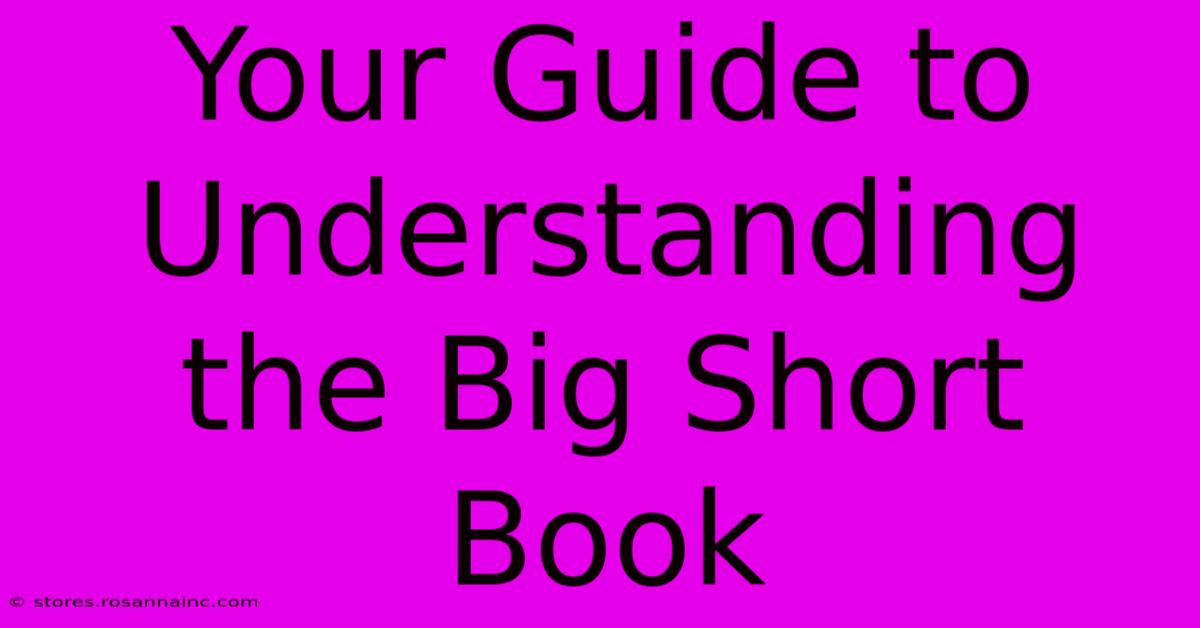Your Guide To Understanding The Big Short Book

Table of Contents
Your Guide to Understanding Michael Lewis's "The Big Short": Inside the 2008 Financial Crisis
Michael Lewis's The Big Short: Inside the Doomsday Machine isn't your typical Wall Street thriller. It's a gripping, often darkly humorous, account of the individuals who saw the impending collapse of the US housing market and, incredibly, profited from it. Understanding the book requires grasping complex financial instruments and the systemic flaws that led to the 2008 financial crisis. This guide will help you navigate the key concepts and characters, making The Big Short more accessible and insightful.
Decoding the Mortgage-Backed Securities (MBS) and Collateralized Debt Obligations (CDOs)
At the heart of The Big Short lie two key financial instruments:
-
Mortgage-Backed Securities (MBS): These are bundles of mortgages sold to investors. Think of it like this: a bank gives out thousands of home loans. It then bundles these loans together and sells them to investors as a single security. The investors receive payments based on the homeowners' mortgage payments. The problem? The risk was poorly assessed, often including subprime mortgages (loans to borrowers with poor credit history).
-
Collateralized Debt Obligations (CDOs): These are even more complex. They're essentially bundles of other debt, including MBSs. This created a chain of risk, where the underlying value of the CDOs was incredibly difficult to determine. The ratings agencies (like Moody's and Standard & Poor's) often gave these highly risky CDOs high ratings, further fueling the market.
The Key Flaw: The system relied on the assumption that housing prices would continue to rise indefinitely. When the housing bubble burst, the entire structure crumbled, leaving investors holding worthless securities.
The Heroes (and Villains) of The Big Short
Lewis introduces us to several key figures who foresaw the impending disaster:
-
Michael Burry: A brilliant but eccentric doctor-turned-hedge-fund manager, Burry was one of the first to recognize the inherent risk in MBSs. His meticulous research and contrarian bets made him a fortune.
-
Steve Eisman: A cynical but ultimately effective hedge fund manager, Eisman used his sharp wit and deep understanding of the market to expose the flaws in the system. His story highlights the moral ambiguities inherent in profiting from others' misfortune.
-
Greg Lippmann: A Deutsche Bank trader, Lippmann played a crucial role in explaining the complex MBS market to investors. His story is an interesting exploration of the motivations of those working within the system.
-
The Banks and Rating Agencies: These institutions, while not individual characters, are portrayed as villains, complicit in creating and perpetuating the risky investment environment. Their pursuit of profit over prudence played a significant role in the crisis.
Why The Big Short Matters Today
The Big Short is more than just a historical account. It serves as a cautionary tale about the dangers of unchecked greed, regulatory failures, and the complexity of financial markets. The book's lessons remain relevant today, reminding us of the importance of:
- Regulatory oversight: Strong regulations and oversight are crucial to prevent similar crises.
- Transparency: The lack of transparency in the mortgage-backed securities market allowed the crisis to build undetected.
- Risk assessment: Accurate and thorough risk assessment is vital in any financial market.
Beyond the Book: The Movie and Its Impact
The success of the film adaptation, also titled The Big Short, broadened the book's reach and brought the complex issues to a wider audience. The movie's use of humor and celebrity cameos helped make the otherwise dense material more accessible.
Understanding The Big Short requires patience and a willingness to grapple with complex financial concepts. But by understanding the key players, the instruments involved, and the systemic failures exposed, readers gain a profound understanding of one of the most significant economic events of the 21st century. This guide serves as a starting point, encouraging further exploration of this critical piece of financial history.

Thank you for visiting our website wich cover about Your Guide To Understanding The Big Short Book. We hope the information provided has been useful to you. Feel free to contact us if you have any questions or need further assistance. See you next time and dont miss to bookmark.
Featured Posts
-
Missing The Excitement Connect With Santa Fe Now
Feb 11, 2025
-
Unleash Your Inner Dragon Mastering Breath Of Fire 3
Feb 11, 2025
-
Nz Vs Sa Odi Williamson Se Hoogtepunte
Feb 11, 2025
-
Bills Stars Sales Pitch To Garrett
Feb 11, 2025
-
Super Bowl 2025 Mahomes Und Kelce Scheitern
Feb 11, 2025
